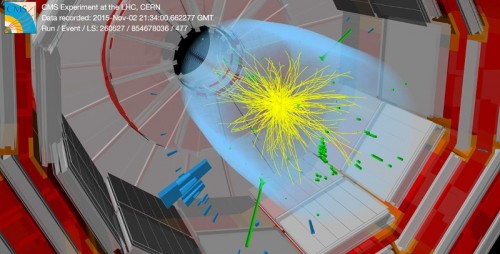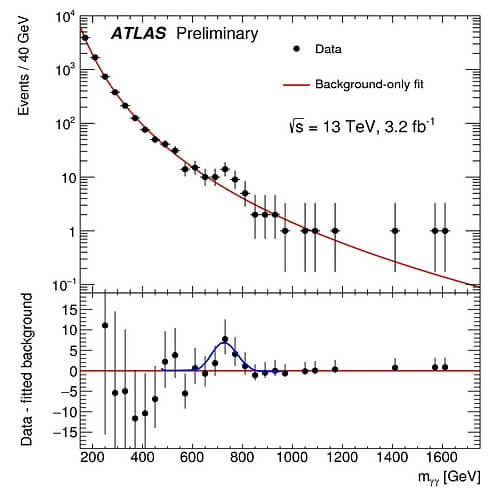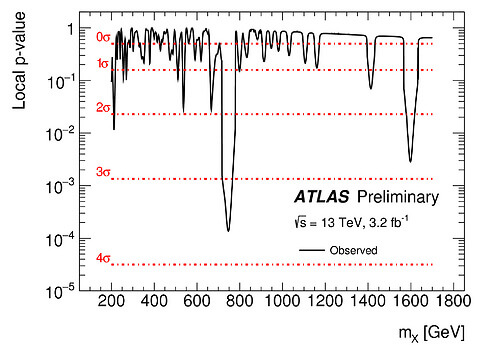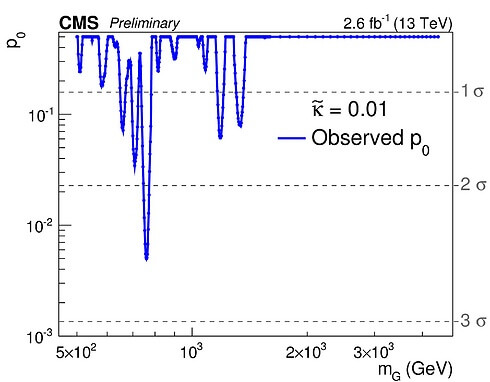When we discovered the Higgs boson no one was surprised. We were waiting for him to appear - and he appeared in all his glory. But now the possibility of the existence of a particle 6 times heavier than the Higgs has been discovered. Prof. Elam Gross explains from Switzerland
Three and a half years have passed since the discovery of the Higgs particle at the Large Particle Accelerator (LHC) in Geneva. In an accelerator, two beams of protons are accelerated to speeds close to the speed of light and collide head-on with energies whose densities are similar to those that prevailed in the universe - a fraction of a second after the big bang. With the discovery of the Higgs boson, the puzzle of what is called the Standard Model was completed.

Suspicion of the existence of a particle 6 times heavier than the Higgs
All the particles predicted by the model were discovered, including: photons, electrons, neutrinos and quarks. But this seemingly perfect puzzle did not please the physicists. The foundations on which the model is based are not strong enough, the masses of the material particles and the large differences between them are not understood and are not naturally accepted by the model. Physicists have created more complex models that extend the Standard Model in a way that solves some of its fundamental problems, such as the ones we pointed out above.
One of the more complex models, as well as the more familiar, is what is called supersymmetry: every particle in the standard model has a heavier brother or sister. None of these have yet been discovered. However, in order to discover heavier particles, greater energies are needed, and therefore after the discovery of the Higgs, the collision energy was doubled and in 2015 it stood at 13 Tev, i.e., an energy that weighed 13,000 times the mass of the proton.
Physicists hoped to find signs of a new heavy particle, but no one thought that we would see something that we did not expect at all. This may be the reason why physicists find it difficult to digest that maybe, and just maybe, we have discovered a new particle, and lower their expectations and hopes to the minimum possible. There is also a solid scientific basis for lowering expectations and it is called in scientific language: The Look Elswhere Effect.
When we discovered the Higgs boson no one was surprised. We were waiting for him to appear - and he appeared in all his glory. Particles such as the Higgs live a very short time and quite immediately decay into other particles. We locate the decay products and recover the original particle from them. And we saw the Higgs decay into two photons, and also into four electrons, and various other modes of decay.
In Figure 1 you see a picture of one of the dozens of events that create the media frenzy that is currently taking place in the scientific world. When you try to interpret the di-photon (Di-Photon), meaning the two photons (which the detector draws as green lines), as products of the decay of a heavy particle, you get that the mass of the particle is about 760 GeV, that is, 6 times heavier than the Higgs boson. We would not be excited by one such particle, because even the standard model predicts the existence of several events whose diphoton mass is in this field. But we get much, much more than the Sanderati model predicts. Then the only question that is asked is how much more and how do you determine it? "How much more" is a reason to hold a press conference and the answer is given in a statistical term called significance.
Significance is measured by the number of standard deviations. For example, if the average height of the American man is 177 cm, with a standard deviation of 8 cm, then about 2/3 of the male population will be between 169-185 cm tall. Michael Jordan is 198 cm tall, which means his height is almost 3 standard deviations above the average. Less than 1/4 percent of men in the US stretch to such a height. Shaquille O'Neal is 216 cm tall, about 5 standard deviations above the average. Only about 30 men out of about 170 million men in the US are that tall. Less than one man per million men - there is no doubt that a man whose height is five standard deviations above the average is unusual and attracts attention. There is no known American man who is six standard deviations above the average height, if you see one on the street you are likely to have come from Mars.
And so the physicists decided that if the number of events with a certain mass is more than five standard deviations higher than expected from the standard model, it is likely that the excess of events does not result from statistical fluctuation but from new particles that are created in the experiment. This is what happened in 2012 with the discovery of the Higgs particle. So the number 5 sigma (or 5 standard deviations) was the magic number and the two trials in the accelerator, Atlas and CMS reported an excess of events above 5 sigma. Each also reported it in two different decay states, one of which was a di-photon. With such a high standard deviation, the probability of error, that is, the probability of a statistical fluctuation in each of the attempts was less than one in a million.
The Higgs particle was discovered at a mass of 125 GeV. In the seminars given in Geneva by the two experiments located in the accelerator, Atlas and CMS, on Tuesday, December 14, 2015, the two experiments reported an excess of di-photon events with a mass of about 750 GeV (6 times the Higgs mass).
In Figure 2 we see the mass distribution of all the di-photons recorded in the Atlas detector in 2015. We see that there are all from 200 to 1600 GeV. The red curve at the top of the image shows the expectation from the standard model. In some masses we see a number of events below the expected and in some, above the expected. The excess of events can be seen at the bottom of the picture (a negative excess means less than expected). In the vicinity of 750 GeV there is an accumulation of events above the expectation which is definitely unusual. The accumulation creates a bump in the bell-shaped distribution (see the blue curve at the bottom of Figure 2). If you adjust the bell for the excess of events, you get about 15 events over the expected of about 15 (about 30 in total) events. The probability of a statistical fluctuation resulting from more than 30 events is less than 1:10000 and corresponds to almost 4 sigma.

If we think a little more deeply we will understand that we would see an excess of events at 600 or 700 or 900 or 200 GeV even then we would be shocked at the sight of the possible discovery. We have to formulate the question differently: "What is the chance of seeing an excess with a significance above 4 sigma at some mass in the search field (and not necessarily at 750 GeV)?". Of course, the probability of seeing an excess anywhere is higher than the probability of seeing it in a certain place. A higher probability leads to a significant decrease in significance.
This effect of reducing significance due to the expansion of the question to search in every mass, and not only in a certain mass, is called the "Look Elsewhere Effect" or the Look Elsewhere Effect (LEE) as we defined above. Calculating the LEE is complicated, but there are formulas that allow it to be done relatively easily. The LEE can also be extended to additional variables in the problem. For example, even if the excess had a wider or narrower bell, it would draw our attention.
Therefore Atlas rephrased the question: "What is the probability of seeing an excess above 4 sigma at any mass and at any width (of the bell) in the search field?" In the answer, the significance dropped to about 2.2 sigma, meaning a probability of about 1.5%. Statistical fluctuations of about 2 sigma are very common when it comes to hundreds if not thousands of measurements. That's why Atlas discovered a change of caution and downplayed the possible discovery.
In the parallel CMS experiment the result was even less clear. In Figure 4 you can see the result of the probability of statistical fluctuations in the search area of CMS. The lowest probability is at a mass of 760 GeV and corresponds to a significance of 2.6 sigma. This is a very small significance and when the LEE effect is taken into account the significance drops to 1.2 sigma, which is practically considered so common that no one pays attention to it.

In the above example, 4 sigma, this is the probability that a random American man will be taller than 209 cm when the average is 177 cm and the standard deviation is 8 cm.
This is a very low probability, or a very high significance. So why didn't Atlas hold a big press conference to announce the discovery of a heavy particle that decays into two photons?
Looking at the lower part of Figure 2, it can be seen that there is an excess of events, although not appreciable, also in the region of 500,1400, 1600 or XNUMX GeV.
Figure 3 shows the probability that any excess of events we see is due to the standard model expectation. In this figure we see that the lowest probability is in the mass region of 750 GeV. As mentioned, the lower the probability, the higher the significance of a "new particle", i.e. an excess that is not a statistical fluctuation. In the area of 750 GeV it is as mentioned close to 4 sigma, but in the area of 1600 GeV you can see a low probability that leads to a significance of close to 3 sigma.
The fluctuations in this figure illustrate that statistical fluctuations are commonplace. Therefore, caution should be taken before declaring that an excess is not the result of a statistical fluctuation (the significance of which is very high) but the result of a new particle.
When we said that the probability of seeing a statistical fluctuation in the region of 750 GeV is less than 1:10000 we answered the question: "What is the probability that the observation of 15 events with a mass of 750 GeV will perform a statistical fluctuation to a higher number than 30 events?"

And yet the very fact that both experiments see the highest significance at the same mass of 750-760 GeV, and in the case of Atlas the significance at a mass of 750 GeV is about 4 sigma, causes a lot of agitation in the scientific community.
At the time of writing these lines, the day after the announcement of the results, dozens of articles by theoretical physicists have already been published that try to explain the observation as a new particle,
and explain why it prefers to decay into photons and why we have not yet seen it in any other form of decay. We will know the answer only when the accelerator, which is currently disabled, is back in operation in the spring of 2017. Until then, the theorists can continue to dream and enjoy the doubt.
The article was first published on the YNET science channel
More of the topic in Hayadan:
- Suspicion of the existence of a particle 6 times heavier than the Higgs
- The existence of the Higgs boson
- Dark matter, dark energy and the fate of the universe - a chapter from the new book "Journey to the Dawn of the Universe"
- The physicist community is expecting new discoveries with the restart of the Axial Accelerator, after it has been upgraded to 13 TeV

9 תגובות
Excellent article
Thanks
The accelerator is closed for renovation or upgrade. It's all. The accelerator is an international success story.
Destination
It seems to me that they are not willing to allocate money for this research because it is very expensive and economically sterile. Barren because the mechanism of particles is so uncontrolled that it is not possible to benefit from them. (If the research was cheap, they would continue the research in the hope that the deficiencies will be corrected. As mentioned, the main problem is the economic problem).
Hi, why is the accelerator closed again until spring 2017? Is it for another upgrade to beyond 13TeV?
It could just be that Higgs has a fat brother who ate a lot of chocolate.
Many thanks to Prof. Elam Gross!
For years I have been looking for short and exhaustive articles on the latest innovations in elementary physics.
Here is a wonderful talk by Nima Arkani Hamad on this topic including an excellent explanation of Super Symmetry
https://www.youtube.com/watch?v=U47kyV4TMnE
High quality and brilliant article.
Elam Gros your king 🙂